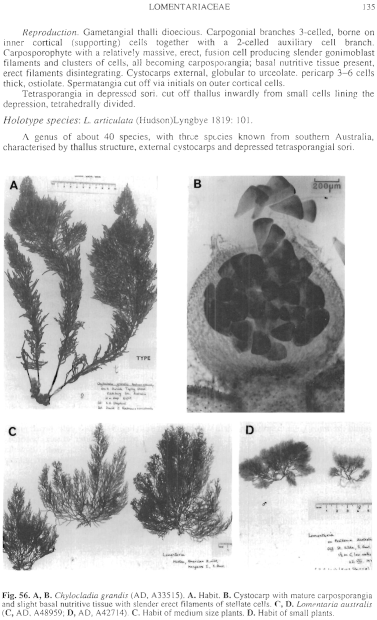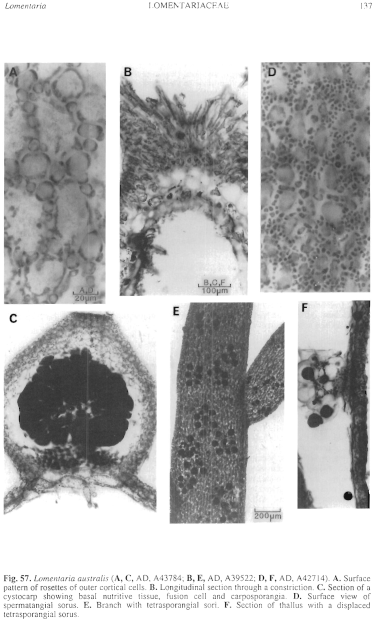|
|
|
|
|
|||||||||||
|
Electronic Flora of South Australia Species Fact Sheet
Phylum Rhodophyta – Class Florideophyceae – Order Rhodymeniales – Family Lomentariaceae
Selected citations: Chapman & Dromgoole 1970: 141. May 1965: 361. Womersley 1950: 176.
Synonyms
Chondrothamnion australe Kützing 1865: 29, pl. 82d-f.
Chrysymenia clavellosa sensu Harvey 1849a: 77.
Chylocladia clavellosa sensu De Toni 1900b: 573. Guiler 1952: 95.Harvey 1859b: 327. Lucas 1929a: 19. Sonder 1881: 17. Tisdall 1898: 506. Wilson 1892: 180.
Lomentaria fruticulosa Reinbold 1899: 46.
Chylocladia fruticulosa (Reinbold) De Toni 1900b: 576. Lucas & Perrin 1947: 208. May 1965: 362.
Thallus (Fig. 56C, D) light to dark grey-red to red-brown, mucilaginous, 5–20 cm high, usually forming spreading tufts, much branched irregularly radially for 3–4 orders, with or without percurrent axes. Branches terete, becoming compressed in larger branches, hollow, basally constricted and tapering to a subacute to rounded apex, main branches 1–2 mm in diameter, decreasing to branchlets 200–500 µm in diameter. Holdfast discoid, 1–2 mm across, sometimes stoloniferous, bearing one to several fronds; epilithic or epiphytic on Posidonia, Amphibolis or larger algae. Structure multiaxial with a cluster of apical cells producing longitudinal filaments which branch and interconnect to form a lax medullary network on the inside of the cortex, filaments 5–12 (–15) µm in diameter, producing directly small, ovoid to subspherical, secretory cells 6–12 (–18) µm in diameter; in older segments, the medulla becomes 3–5 filaments thick, moderately dense near the thallus base. Cortex cut off outwardly from the subapical cells, at first as odd cells, becoming 2 cells thick above and 3–6 cells thick below, with a continuous inner cortex of larger, ovoid to elongate cells mostly L/B 1.5–2.5 and 20–60 µm in diameter, and an outer cortex of smaller cells cut off around the inner cells, subdividing below to form rosettes (Fig. 57A) 2–3 cells broad and 2 cells thick, outer cells 2–5 µm in diameter; on older parts the outer cortex becomes continuous. Branch constrictions solid (Fig. 57B), pseudoparenchymatous, with filaments growing into the branch cavity. Hairs frequent. Rhodoplasts ovoid to elongate, irregularly shaped in inner cells, often in chains.
Reproduction: Gametangial thalli dioecious. Carpogonial branches unknown. Carposporophyte (Fig. 57C) erect, with a basal fusion cell, branched above with several appressed lobes of ovoid or clavate to cuneate carposporangia each (25–) 40–60 µm broad; basal nutritive tissue present, erect cells becoming stellate and disintegrating. Cystocarps external, scattered and often borne near branch bases, globular to urceolate and slightly basally constricted, 300–800 µm in diameter, ostiolate, pericarp 40–80 µm and 3–5 cells thick (more around ostiole), inner cells stellate. Spermatangial initials produced from cells of outer cortical rosettes (Fig. 57D), spermatangia ovoid, 2–3 µm in diameter.
Tetrasporangia in scattered, round to elongate, depressed, sori (Fig. 57E) 80–500 µm across, cut off thallus inwardly (Fig. 57F) from small cells lining the depression, few to numerous per sorus, subspherical, (35–) 40–70 µm in diameter, tetrahedrally divided.
Type from "Nova Hollandia"; holotype in Herb. Kützing, L, 940, 284 ... 259.
Selected specimens: Waldegrave I., S. Aust., 22 m deep (Shepherd, 23.x.1970; AD, A37401). Elliston, S. Aust., 4 m deep on Codium galeatum (Shepherd, 22,x.1970; AD, A37519). Outside Kellidie Bay, Coffin Bay, S. Aust., upper sublittoral (Womersley, 22.viii.1967; AD, A31853). Yatala Harbour, N Spencer Gulf, S. Aust., 7 m deep on Posidonia sinuosa (Johnson, Nov. 1975; AD, A54940). Off St Kilda, S. Aust., 1.5 m deep on Posidonia australis (S. Lewis, 23.viii.1972; AD, A42714) and 3–4 m deep (Wickes, 3.viii.1973; AD, A43784). Gypsum wharf, Ballast Head, Kangaroo I., S. Aust., 0–5 m deep (Kraft, 16.vii.1972; AD, A42483). Muston, American R. inlet, Kangaroo I., S. Aust., 4–5 m deep (Shepherd, 29.xii.1977; AD, A48959). Pennington Bay, Kangaroo I., S. Aust., drift (Womersley, 22.viii.1954; AD, A19764). Port MacDonnell, S. Aust., drift (Womersley, 15.v.1982; AD, A53166). Apollo Bay, Vic., 0–0.5 m deep on pipeline (Kraft & Owen, 1.ix.1971; AD, A39522). Swan Bay, Port Phillip, Vic., 0.5 m deep (Watson, 30.ix.1973; AD, A44128). Low Head, Tas., drift (Perrin, 11.ix.1937; AD, A8501). Lady Bay, Southport, Tas., 7 m deep (Brown & Kenchington, 14.x.1986; AD, A57690).
Distribution: Elliston, S. Aust., to Port Phillip, Vic., and around Tasmania. New Zealand?
Taxonomic notes: The type of Lomentaria australis is a relatively robust specimen, similar to those from Tasmania.
Lomentaria australis Areschoug mscr., referred to by Sonder 1853, p. 693 as possibly Chylocladia tasmanica Harvey (1844, p. 444) is a nomen nudum. The latter is an earlier name for Coeloclonium opuntioides (Harvey) J. Agardh, which is correctly known as Coeloclonium tasmanicum (Harvey) Womersley, comb. nov. [Basionym Chylocladia tasmanica Harvey 1844b, p. 444.]
L. australis has been credited to N.S.W. but these records are referred to L. catenata by Millar & Kraft (1993, p. 30). However, a slender, irregularly branched Lomentaria does occur on the N.S.W. coast and may well be L. australis.
L. fruticulosa Reinbold (1899, p. 46) is based on a collection by A.E. Davey from Sturt Bay, S. Aust. An isotype specimen in AD (A1533) is epiphytic on Posidonia australis and appears to be a small plant of L. australis.
References:
CHAPMAN, V.J. & DROMGOOLE, F.I. (1970). The marine algae of New Zealand, Part III: Rhodophyceae. Issue 2: Florideophycidae: Rhodyméniales, pp. 115–154, Plates 39–50. (Cramer: Germany.)
DE TONI, G.B. (1900b). Sylloge Algarum omnium hucusque Cognitarum. Vol. 4. Florideae. Sect. 2, pp. 387–776. (Padua.)
GUILER, E.R. (1952). The marine algae of Tasmania. Check List with localities. Pap. Proc. R. Soc. Tasm. 86, 71–106.
HARVEY, W.H. (1844b). Algae of Tasmania. Lond. J. Bot. 3, 428–454.
HARVEY, W.H. (1849a). Nereis Australis, pp. 65–124, Plates 26–50. (Reeve: London.)
KÜTZING, F.T. (1865). Tabulae Phycologicae. Vol. 15. (Nordhausen.)
LEVRING, T. (1946). A list of marine algae from Australia and Tasmania. Acta Horti gothoburg 16, 215–227.
LUCAS, A.H.S. & PERRIN, F. (1947). The Seaweeds of South Australia. Part 2. The Red Seaweeds. (Govt Printer: Adelaide.)
LUCAS, A.H.S. (1929a). The marine algae of Tasmania. Pap. Proc. R. Soc. Tasm. 1928, 6–27.
MAY, V. (1965). A census and key to the species of Rhodophyceae (red algae) recorded from Australia. Contr. N.S.W. natn. Herb. 3, 349–429.
MILLAR, A.J.K. & KRAFT, G.T. (1993). Catalogue of Marine and Freshwater Red Algae (Rhodophyta) of New South Wales, including Lord Howe Island, South-western Pacific. Aust. Syst. Bot. 6, 1–90.
REINBOLD, T. (1899). Meeresalgen von Investigator Street (Slid Australien), gesammelt von Miss Nellie Davey (Waltham, Honiton). Hedwigia 38, 39–51.
SONDER, O.W. (1853). Plantae Muellerianae. Algae. Linnaea 25, 657–709.
SONDER, O.W. (1881). In Mueller, F., Fragmenta Phytographiae Australiae. Supplementum ad volumen undecinum: Algae Australianae hactenus cognitae, pp. 1–42, 105–107. (Melbourne.)
TISDALL, H.T. (1898). The algae of Victoria. Rep. 7th Meet. Aust. Ass. Adv. Sci., Sydney, 1898, pp. 493–516.
WILSON, J.B. (1892). Catalogue of algae collected at or near Port Phillip Heads and Western Port. Proc. R. Soc. Vict. 4, 157–190.
WOMERSLEY, H.B.S. (1950). The marine algae of Kangaroo Island. III. List of Species 1. Trans. R. Soc. S. Aust. 73, 137–197.
The Marine Benthic Flora of Southern Australia Part IIIB complete list of references.
Publication:
Womersley, H.B.S. (28 June, 1996)
The Marine Benthic Flora of Southern Australia
Rhodophyta. Part IIIB. Gracilarialse, Rhodymeniales, Corallinales and Bonnemaisoniales
Reproduced with permission from The Marine Benthic Flora of Southern Australia Part IIIB 1996, by H.B.S. Womersley. Australian Biological Resources Study, Canberra. Copyright Commonwealth of Australia.
Illustrations in Womersley Part IIIA, 1996: FIGS 56C, D, 57.

Figure 56 enlarge
Fig. 56. A, B. Chylocladia grandis (AD, A33515). A. Habit. B. Cystocarp with mature carposporangia and slight basal nutritive tissue with slender erect filaments of stellate cells. C, D. Lomentaria australis (C, AD, A48959; D, AD, A42714). C. Habit of medium size plants. D. Habit of small plants.

Figure 57 enlarge
Fig. 57. Lomentaria australis (A, C, AD, A43784; B, E, AD, A39522; D, F, AD, A42714). A. Surface pattern of rosettes of outer cortical cells. B. Longitudinal section through a constriction. C. Section of a cystocarp showing basal nutritive tissue, fusion cell and carposporangia. D. Surface view of spermatangial sorus. E. Branch with tetrasporangial sori. F. Section of thallus with a displaced tetrasporangial sorus.

|
Email Contact: State Herbarium of South Australia |

|